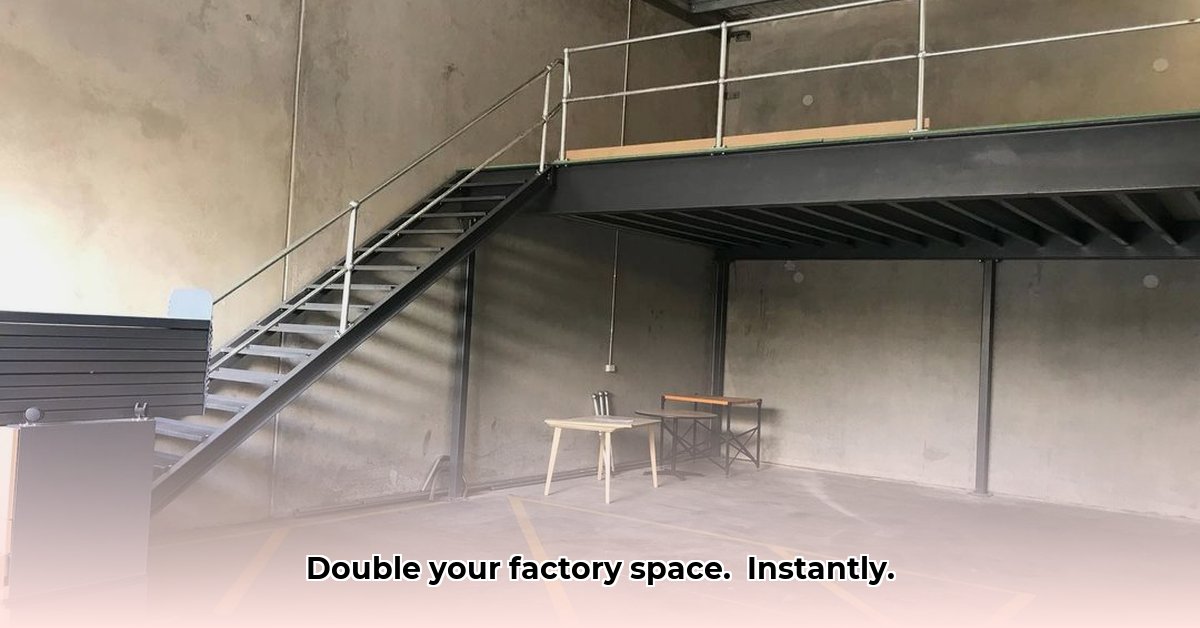Is your factory struggling with limited space? A mezzanine floor could be the answer! This comprehensive guide provides insights into planning, design, and installation, helping you make informed decisions. Discover how to unlock your factory’s hidden potential and optimize workflows. For more warehouse solutions, check out this helpful resource on mezzanine floor solutions.
Mezzanine Floor: Unlocking Your Factory’s Hidden Potential
Is your factory feeling cramped, with tangled production lines and overflowing storage? Many factories face the challenge of limited space, hindering growth and efficiency. What if you could dramatically increase your usable area without a costly and disruptive building expansion? A mezzanine floor offers a practical solution, adding another floor to your factory without the expense of building a whole new story. Think of the possibilities: extra space for storage, a dedicated office area, or a new assembly line, all within your existing building. A mezzanine floor directly addresses space constraints, potentially optimizing workflows, reducing clutter, and improving overall organization.
Exploring Mezzanine Structural Options
Not all mezzanine floors are created equal. Choosing the right type depends on your specific needs, existing factory layout, and budget. Here are some popular options:
-
Freestanding Mezzanines: These standalone structures are independent of your existing building’s framework. They’re versatile and relatively easy to install, making them a popular choice for factories needing added space without major construction modifications. Freestanding mezzanines often require minimal disruption to existing operations during installation.
-
Rack-Supported Mezzanines: If you already have extensive racking systems, a rack-supported mezzanine is a space-saver. It utilizes your existing racking as support for the new floor, minimizing material costs and installation time. However, ensure your existing racks are capable of handling the additional load.
-
Custom Mezzanines: Tailor the structure to precise specifications, load requirements, and your unique factory layout, offering complete flexibility. Custom mezzanines are ideal for factories with unusual layouts or specific operational needs, allowing for integration with existing equipment and processes.
-
Steel Mezzanines: Known for their durability and high load-bearing capacity, steel mezzanines are a robust solution for industrial environments. They can support heavy machinery, equipment, and storage, making them suitable for demanding applications.
-
Modular Mezzanines: These pre-engineered systems offer flexibility and ease of installation. They can be easily reconfigured or relocated as your needs change, providing a cost-effective and adaptable solution for growing businesses.
Planning Your Mezzanine Installation: A Step-by-Step Guide
Installing a mezzanine floor requires careful planning and execution. A well-defined plan minimizes disruptions and ensures a successful outcome.
- Needs Assessment: Conduct a thorough assessment of your factory. Identify your specific needs: How much extra space do you require? What will this space be used for (storage, office, production)? What’s the anticipated weight load (machinery, storage, personnel)? What are your vertical clearance requirements? Understanding these factors is crucial for effective planning.
- Design and Engineering: Partner with a structural engineer experienced in mezzanine design. They will create blueprints that comply with all relevant building codes, safety regulations (OSHA, IBC), and seismic requirements. Be sure to obtain detailed drawings and specifications.
- Permitting and Approvals: Obtain all the necessary building permits and approvals from your local authorities. This might involve submitting detailed plans, structural calculations, and undergoing inspections. Factor permit processing times into your project timeline.
- Choosing Your Contractor: Select a reputable and experienced contractor specializing in mezzanine installation. Check references, review their past projects, and ensure they have the necessary insurance, licenses, and certifications. A qualified contractor will adhere to safety protocols and ensure a quality installation.
- Utility Integration: Plan for the integration of essential utilities like electricity, lighting, HVAC, and potentially data and communication lines to your new mezzanine. Consider energy-efficient lighting options to reduce operating costs.
- Safety Features: Include safety features such as guardrails, stair systems, safety gates, and fire protection systems in your mezzanine design. Ensure these features meet or exceed all relevant safety standards and regulations.
Weighing the Pros and Cons: Is a Mezzanine Floor Right for You?
Carefully consider both the advantages and potential drawbacks before making a final decision.
Advantages:
- Expanded Usable Space: Significantly increases your factory floor space without expanding the building’s footprint.
- Improved Efficiency: Optimizes workflows, reduces material handling time, enhances overall facility organization, and improves inventory management. This generally translates to improved productivity and potentially lower operating costs.
- Enhanced ROI: The long-term benefits—increased production, optimized operations, and better space utilization—often lead to a strong return on investment.
- Adaptability: Mezzanines are generally adaptable to changing business needs. They can be reconfigured or relocated as your operations evolve.
- Cost-Effectiveness: Mezzanines are a cost-effective alternative to building expansion, saving you money on construction costs, property taxes, and utility bills.
- Safety and Compliance: A properly designed and installed mezzanine meets all relevant safety standards, providing a secure working environment for your employees.
Potential Drawbacks:
- Upfront Investment: The initial cost of design, materials, and installation can be substantial.
- Height Restrictions: Existing ceiling heights could limit the size and capabilities of your mezzanine.
- Building Structural Integrity: Ensure your building’s structure can safely support the added weight of a mezzanine. Conduct a structural analysis to assess the building’s load-bearing capacity.
- Disruption During Installation: The installation process can disrupt normal factory operations. Plan carefully to minimize downtime.
- Accessibility: Moving materials to and from a mezzanine requires a solution (VRC, forklift, etc.).
The Final Decision: Is a Mezzanine Floor Your Solution?
Does the projected return on investment justify the initial expense? Consider the potential for increased productivity, reduced operating costs, and improved space utilization. If your answers lean heavily toward “yes,” a mezzanine floor is likely a smart investment. It offers a viable path to expanding your factory’s capabilities, improving efficiency, and boosting your bottom line without the complexities of a complete building overhaul.
Calculating ROI for Industrial Mezzanine Floor Installation
Before diving into the numbers, let’s clarify your needs. What are your current space constraints? What processes could benefit from a mezzanine? Defining these needs focuses your investment and ensures you choose the right size and type of mezzanine when figuring out how to calculate roi for industrial mezzanine floor installation.
Step-by-Step ROI Calculation
Calculating the ROI involves a few key steps and careful consideration of both costs and benefits.
- Determine Initial Investment Costs: This includes design fees, materials (steel, decking, etc.), installation labor, permits, any necessary structural modifications to your existing building, safety features (guardrails, stairs), and utility connections.
- Calculate Increased Usable Space: Measure the square footage gained from the mezzanine. This will be a key factor in determining the potential for increased productivity and revenue.
- Estimate Cost Savings: Quantify your savings—reducing rental costs by avoiding expansion, improved workflow efficiency saving you in labor costs, reduced material handling costs, and decreased energy consumption (through optimized lighting and HVAC systems). Don’t underestimate the benefits!
- Project Increased Revenue: Calculate the potential revenue generated from additional space, allowing for increased production, new product lines, or expanded storage capacity. This is crucial when figuring out how to calculate roi for industrial mezzanine floor installation.
- Factor in Ongoing Costs: Include annual maintenance, insurance, property taxes (if applicable), potential repairs, and utility costs associated with the mezzanine.
- Calculate the ROI: A simple ROI formula is:
(Total Benefits – Total Costs) / Total Costs) * 100%. However, a more comprehensive ROI calculation should consider the time value of money and factor in the payback period.
Mezzanine Floor Types and Their Impact on ROI
Choosing the right mezzanine type significantly impacts your ROI. Steel mezzanines are durable and offer high load capacities but come with a higher upfront cost compared to modular mezzanines, which are adaptable and can be expanded, potentially improving your long-term ROI. Consider the trade-offs between upfront costs, durability, flexibility, and load-bearing capacity when selecting a mezzanine type. This helps with understanding how to calculate roi for industrial mezzanine floor installation.
Mitigating Project Risks
Proper planning, careful contractor selection, and adherence to safety regulations are crucial for mitigating risks and ensuring a positive ROI.
- Engage a reputable contractor with experience in mezzanine installations.
- Ensure the design complies with all relevant building codes and safety regulations.
- Conduct regular maintenance inspections to safeguard your investment and prevent costly repairs.
- Obtain proper insurance coverage to protect against potential liabilities.
Beyond the Numbers: Qualitative Benefits
Remember, ROI isn’t just about the numbers. A mezzanine enhances workplace safety, improves employee morale, and could even attract new clients.
- Enhanced Workplace Safety: A well-designed mezzanine with proper safety features creates a safer working environment for employees.
- Improved Employee Morale: A clean, organized, and efficient workspace can boost employee morale and productivity.
- Enhanced Company Image: A modern and well-organized factory can impress clients and improve your company’s image.
Consider those factors beyond financial metrics when you think about how to calculate roi for industrial mezzanine floor installation. Plus, space optimization enhances productivity
- Glass Tile Shower Ideas to Create a Stunning Bathroom Space - December 7, 2025
- Glass Wall Tile Ideas for Kitchens and Bathrooms - December 6, 2025
- Glass Tile Bathroom: Create a Beautiful, Easy-Clean Space - December 5, 2025










